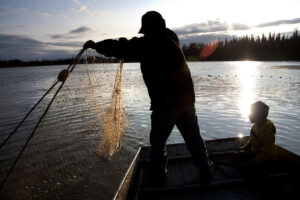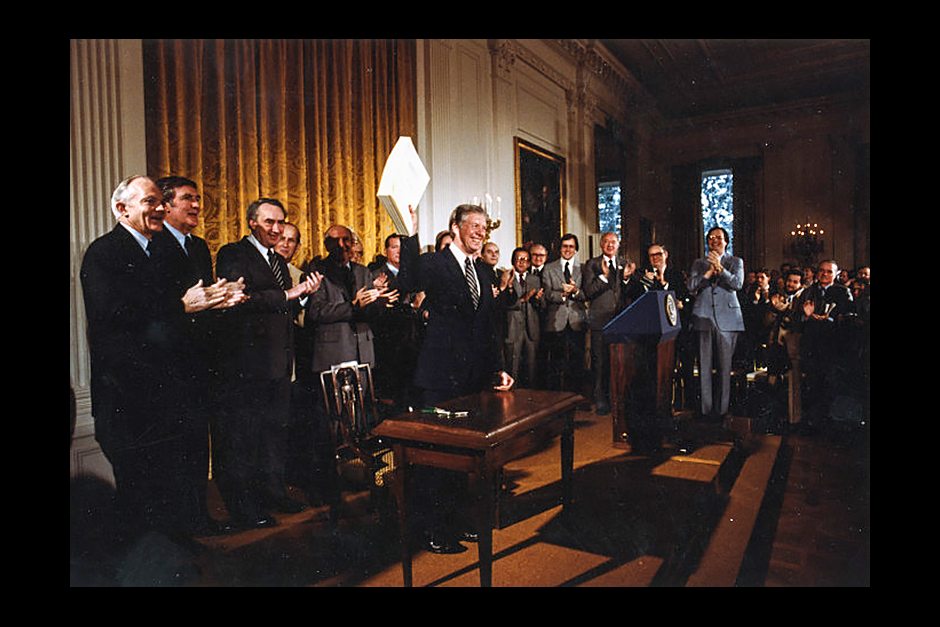
Celebrating 35 Years of ANILCA

President Jimmy Carter celebrates after signing the Alaska National Interest Lands Conservation Act on December 2, 1980. Jimmy Carter Presidential Library photo.
The Alaska National Interest Lands Conservation Act (ANILCA) is considered by some to be the most important conservation legislation ever passed. President Jimmy Carter signed ANILCA into law thirty-five years ago today, on December 2, 1980, after decades of legislative and advocacy efforts. The goals were primarily twofold: to protect and safeguard Alaska’s exceptional ecological and natural resources for the national public interest and to protect them for subsistence use by Alaska Natives.
Congress sought in ANILCA to preserve for future generations certain lands and waters in the State of Alaska that had nationally significant values, including areas important for wildlife, subsistence, wilderness, recreation, scientific, scenic, and historic reasons.
ANILCA created or added to 13 national parks, 16 wildlife refuges, 2 national forests, 2 national monuments, 2 conservation areas, and 26 wild and scenic rivers. All-in-all ANILCA protected more than 104 million acres in Alaska. Nearly half of the land, 57 million acres, was set aside as designated Wilderness, the highest level of protection for our public lands. Many consider Alaska’s public lands as the crown jewels of the national conservation systems. It is an exceptional piece of legislation in what it accomplished on a landscape scale, and it continues to contribute to the vibrant and ecologically rich Alaska of today.
History of ANILCA’s Passage
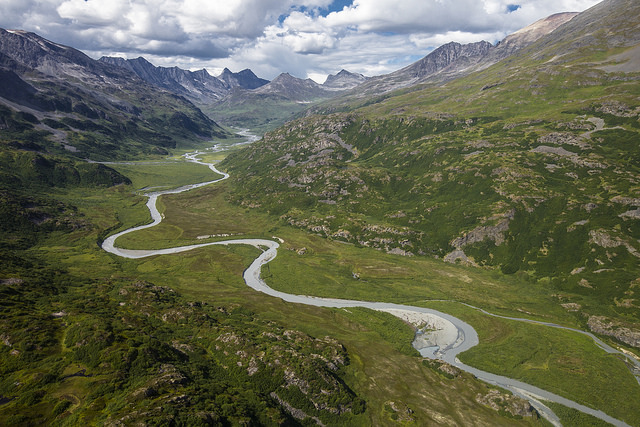
Wrangell-St. Elias National Park and Preserve was established under ANILCA because of its grand mixture of volcanoes, glaciers, wildlife, history, and continuous Native use by the Ahtna. NPS photo.
The momentum behind protecting lands in Alaska for the national public interest began well before Alaska was admitted as the 49th state. Alaska’s rich natural resources have long attracted outside interests seeking to export Alaska’s oil, fish, timber, and minerals.
Logging in southeast, oil development in the Bering River area and on the Kenai Peninsula, commercial fishing in inland and marine waters, and mining of Alaska’s mineral resources were all taking place long before Alaska became a state. Alaska’s first public land was established in 1892 with the creation of Afognak Island as a forest reserve and fish culture station. Alaska’s two National Forests, the Tongass and the Chugach, as well as three gems of the National Park system, Glacier Bay, Katmai, and Denali, were all created in recognition of their outstanding values and need for protection decades before statehood. The efforts to protect Alaska’s exceptional national areas have enjoyed bipartisan support, from Teddy Roosevelt, to Woodrow Wilson, to Franklin Roosevelt, to Dwight Eisenhower.
When Alaska became a state in 1959, the United States gave Alaska the right to select 105 million acres of unreserved federal lands. This amount was five times the amount awarded to any other state. Prudhoe Bay and the central North Slope were areas that the State selected. It was the discovery of oil on state land at Prudhoe Bay in 1968 that led to significant changes for the State. In order to deliver North Slope oil to market, a pipeline to an ice-free tidewater port was needed. Such a pipeline would have to cross land that was claimed by, among others, Alaska Natives who vigorously and successfully asserted their right to settle their land claims before the construction of a pipeline.
That effort led to passage of the Alaska Native Claims Settlement Act (ANCSA) in 1971. Through ANCSA, Congress provided 44 million acres of land and nearly $1 billion to newly-created regional and village corporations, and also extinguished title to aboriginal lands in Alaska. At the same time, ANCSA failed to resolve the rights of Alaska Natives to continued access to and use of subsistence resources, deferring resolution of those issues to a later time. Conservation of some federal lands also remained unresolved by ANCSA, but Congress authorized the Secretary of the Interior to withdraw up to 80 million acres to study for possible designation as, or additions to, national parks, national refuges, national forests, wild and scenic rivers, and the wilderness preservation system. Those withdrawals were not permanent; they required subsequent action to ensure permanent protection. It was these two issues left unresolved by ANCSA—protection for subsistence and conservation of public lands—that laid the foundation for ANILCA.
Legislation that would carry out ANCSA’s unfinished business of setting aside public lands in Alaska for conservation was first introduced in 1977. That bill did not pass and the clock on the ANCSA land withdrawals ticked toward expiration, meaning that millions of acres of national public lands might be selected by other interests and would not be available for inclusion in conservation systems.
After Congress’ failure to act on a conservation bill and the nearing expiration of the ANCSA withdrawals, President Carter and Secretary of the Interior Cecil Andrus used executive authority to withdraw more than 150 million acres. These executive actions kick-started the final legislative push to protect our national public lands and pass ANILCA. After various bills were introduced and amendments made, numerous committee hearings held, and extensive negotiations, ANILCA was passed by Congress and signed by President Carter on December 2, 1980.
ANILCA Supports Strong Economies
ANILCA was exceptionally forward-thinking in what it accomplished. It made long-term decisions about conservation and subsistence that continue to benefit Alaska, Alaska Natives, and the nation today. The conservation benefits of ANILCA have translated into strong economic benefits for Alaskans and Alaska communities. Outdoor recreation alone generates $9.5 billion dollars of spending in Alaska, supporting 92,000 direct jobs and providing $711 million in state and local tax revenue annually.
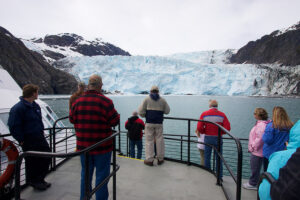
Visitors watch the calving Holgate Glacier on a boat trip into Kenai Fjords National Park. Locals that initially were against the creation of the park, now embrace it as a wonderful asset for the local economy. NPS photo by Jim Pfeiffenberger.
More than a million out-of-state visitors flock to Southeast Alaska each year, supporting 10,200 jobs that contribute another $1 billion to the regional economy. In 2014, Denali National Park (the third most visited national park in the country) hosted over 530,000 visitors, who spent over $5 million in communities near the park, supporting nearly 7,000 area jobs, and generating a total economic benefit to the local economy of nearly $7.5 million. In 2011, more than 570,000 people visited the Kenai National Wildlife Refuge, generating more than $113 million in economic benefit for the area. In 2010, Bureau of Land Management lands in Alaska contributed over 1,000 jobs, received over 600,000 visitors, and generated over $28 million from recreational use.
Alaskan residents spent as much $247.8 million each year in local communities as a result of their use of Alaska’s two national forests, the Chugach and Tongass. In 2012, guided hunters spent a total of $51 million on hunting packages and another $3.5 million on associated services while in Alaska. Almost half of the guiding revenue was earned hunting on federal land. ANILCA lands also support the healthy ecosystems that are necessary to sustain fishing year after year. A 2001 study estimates that Alaska’s commercial fishing industry supplies 20,000 direct jobs and supports an additional 14,000 indirect jobs.
Looking Toward the Next 35 Years
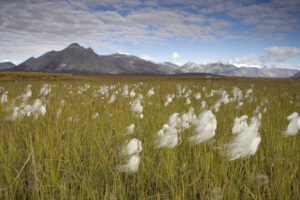
Arctic National Wildlife Refuge was initially established in 1960 to preserve its unique wildlife, wilderness and recreational values. It was expanded under ANILCA to also ensure a place for hunting and gathering activities, protect water quality and quantity, and fulfill international wildlife treaty obligations. USFWS Photo.
ANILCA truly was monumental in what it accomplished. It was the culmination of extensive work by conservation, Alaska Native, state, and federal interests. While some work remains to be done, in large part it has accomplished its central goal of protecting national public interest lands on a landscape scale. Through ANILCA, Congress also helped protect access for Alaskans to subsistence resources, and the interests of a young state to access its unprecedented wealth in state-owned lands and resources. While there remain areas where Congress should act to complete ANILCA’s vision and areas where Congress can act to protect and enhance ANICLA’s goals, the central vision and purpose of ANILCA remains strong today. It has safeguarded some of the nation’s most cherished public lands for the benefit of future generations of Alaskans and all Americans.
Unfortunately, the threats to ANILCA’s integrity began almost as soon as it was passed. From land exchanges, to recommendations to open the entire Coastal Plain of the Arctic National Wildlife Refuge to oil and gas development, to weak regulations and agency directives for its implementation, attempts to weaken ANILCA’s protections have been frequent. But because of the constant involvement of dedicated Alaskans, including Alaska Natives and conservationists within the state, and strong opposition from across the nation to protect our national land treasures, many of these threats have been defeated or pushed back.
ANILCA has ensured that we also have sustainable environmental resources that are the envy of the world and which will continue to be an important foundation for jobs and the economy of Alaska. This is a legacy both to be proud of and to advance into the future.



